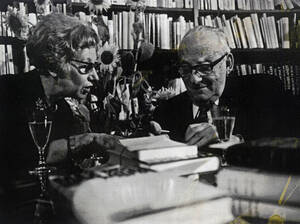by Sheera Frenkel - NPR - May 30, 2012
Natan Dvir/PolarisFranz Kafka, who died in 1924, studied Hebrew in Germany during the last two years of his life. This is one of eight notebooks of his Hebrew studies that are part of the Israeli National Library's collection. Israel and an elderly Israeli woman are wrangling over Kafka documents that may include unpublished manuscripts.
The rest of his work was largely kept secret, and literary scholars have long wondered what gems they might find among Kafka's papers.
The answer may ultimately lie on Tel Aviv's Spinoza Street, inside a small, squat apartment building covered with dirty, pinkish stucco that looks like it's seen better days.

EnlargeImagno/Getty ImageFranz Kafka (shown here circa 1905) is considered one of the 20th century's most influential writers. Before his death in 1924, he had published only short stories and a single novella, The Metamorphosis.
Imagno/Getty Image
Franz Kafka (shown here circa 1905) is considered one of the 20th century's most influential writers. Before his death in 1924, he had published only short stories and a single novella, The Metamorphosis.
The state of Israel and Hoffe, who's in her late 70s, are locked in a battle over those papers, and Hoffe has not been willing to allow outsiders to see them.
For the past 40 years, the women of the Hoffe family have held an assortment of Kafka's primary drafts, letters, drawings and, possibly, unpublished manuscripts.
Journalist Ofer Aderet, with the Haaretz newspaper, says the women have guarded them closely, and to this day no one is sure exactly what they contain. "It's a big secret. It's the $1 million question," he says.
Aderet has been following the three-year court case over the ownership of the papers. The legal wrangling has pitted the Hoffe family against Israel's National Library. Aderet says that within the month, the courts are expected to issue their ruling.
Kafka Wanted His Papers Burned
Anat Perry is an academic and former researcher on the Kafka case for the National Library. The story, she says, begins with a brown suitcase packed by Max Brod, a writer best known as Kafka's friend and biographer.

The author Max Brod was Kafka's friend, literary agent and biographer. Kafka wanted him to burn his papers upon his death. But Brod published some of the work and bequeathed the remainder to his secretary, Esther Hoffe (shown here). Polaris
Kafka, who died in June 1924, wanted all his papers burned.
In Tel Aviv, Brod had a relationship with Esther Hoffe. He often referred to Hoffe as his secretary, though most, including Perry, believe they carried on romantically under the nose of Hoffe's husband and their two daughters.
"She did not raise them at home because she was all the days with Max Brod. I am not surprised if they blamed him for the kind of life that they had — which was not very happy," Perry says.
When Brod died in 1968, he left the Kafka papers to Esther Hoffe. She, in turn, left them to her two daughters, Eva and Ruth.
Eva Hoffe's Legacy
Today, only Eva Hoffe is still alive. Never married, she lives with her cats on Spinoza Street and is rarely seen in public.
Full story at NPR
No comments:
Post a Comment